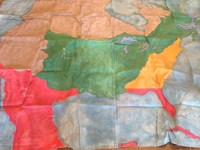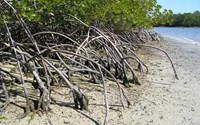- Lesson Plan (34)
- Distance Learning (8)
- Field Trips (8)
- Student Activities (3)
- Teacher Reference Materials (1)
- Glacier Bay National Park & Preserve (14)
- Fort Necessity National Battlefield (11)
- Captain John Smith Chesapeake National Historic Trail (5)
- Everglades National Park (4)
- Chesapeake Bay (3)
- Fort Vancouver National Historic Site (2)
- Gateway Arch National Park (2)
- Historic Jamestowne Part of Colonial National Historical Park (2)
- Acadia National Park (1)
- Show More ...
- Social Studies (34)
- Science (28)
- Literacy and Language Arts (19)
- Math (5)
Showing 55 results for Frenchman Bay ...
I Notice I Wonder: Frenchman Bay View
- Type: Student Activities
- Grade Levels: Lower Elementary: Pre-Kindergarten through Second Grade
Share any or all of the ~1-minute non-narrated resource video clips of Acadia National Park with your students. Encourage them to generate "I Notice, I Notice, I'm Reminded of" statements to share. These statements help promote descriptive observations, thoughtful questions, & relatable connections. This fact sheet can be used to compliment a student-centered discussion! Topic: Frenchman Bay
French and Indian War Activity
- Type: Field Trips
- Grade Levels: Upper Elementary: Third Grade through Fifth Grade
George Washington and the French and Indian War
- Type: Distance Learning
- Grade Levels: Middle School: Sixth Grade through Eighth Grade
Talk with one of Fort Necessity National Battlefield’s park rangers via video conferencing equipment about young George Washington and the French and Indian War. Using George Washington’s actions and writings students will see how his ambition, hard work and experiences helped him mature into the famous man we all know today.
Visiting Glacier Bay
- Type: Distance Learning
- Grade Levels: Lower Elementary: Pre-Kindergarten through Second Grade
Survivor Glacier Bay
- Type: Distance Learning
- Grade Levels: Upper Elementary: Third Grade through Fifth Grade
The Washingtons in Chesapeake Bay History
The French and Indian War 1754-1763: Biography Cards - Unit 7
- Type: Lesson Plan
- Grade Levels: Upper Elementary: Third Grade through Fifth Grade
In this unit students learn about 27 people who participated in the French and Indian War through biography cards written for the students to read. Each card is illustrated with artifacts, documents and a timeline of the person's life. There are nine American Indian, nine French and nine British biography cards. Included are four activities to help the students will learn interesting facts about the participants and how they were affected by the French and Indian War.
The French and Indian War 1754-1763: What Were They Fighting For? - Unit 2
- Type: Lesson Plan
- Grade Levels: Upper Elementary: Third Grade through Fifth Grade
This unit teaches the students what were the wants and needs of the British, French and American Indians. When there was conflict each group would fight to preserve what they wanted and needed. The three student reading outline what each of the three groups valued. The lesson includes background information and one student activity
The French and Indian War 1754-1763: Primary Documents and Artifacts - Unit 8
- Type: Lesson Plan
- Grade Levels: Upper Elementary: Third Grade through Fifth Grade
Bears of Glacier Bay 2: The Scoop on Poop
- Type: Lesson Plan
- Grade Levels: Middle School: Sixth Grade through Eighth Grade
Let's Go Whale Watching in Glacier Bay!
- Type: Distance Learning
- Grade Levels: Upper Elementary: Third Grade through Fifth Grade
Glacier Bay is home to one of the world's most intriguing marine mammals - the endangered Humpback Whale. Come join a Glacier Bay Park Ranger on an interactive journey to learn more about this endangered species. Students will take a look at how Humpback Whales interact with their environment and what Park Researchers are doing to protect them.
Bears of Glacier Bay 3: Be Bear Aware
- Type: Student Activities
- Grade Levels: Middle School: Sixth Grade through Eighth Grade
Students will become “bear aware” by exploring ways to reduce human-bear interactions and applying them to different real-life scenarios. They will use critical thinking skills to make a list of considerations when camping, hiking, fishing, and at home. Students will conclude by creating a “Bear Aware Campaign” by making posters, creating podcasts or videos, or writing news stories.
The French and Indian War 1754-1763: How Did the Conflict Begin? - Unit 3
- Type: Lesson Plan
- Grade Levels: Upper Elementary: Third Grade through Fifth Grade
This unit teaches the students how the French and Indian War began. The students learn about George Washington’s 1753 trip to Fort LeBoeuf, read about George Washington in the French and Indian War, analyze the Fort Necessity surrender document and learn how Benjamin Franklin participated in the war. The lesson includes background information and four student activities
The French and Indian War 1754-1763: How Did The War End? - Unit 5
- Type: Lesson Plan
- Grade Levels: Upper Elementary: Third Grade through Fifth Grade
This unit teaches the students about how the war ended with the Treaty of Paris, and what the consequences were to the different groups who were involved. Both the American colonists and the American Indians were not involved in the peace treaty. The lesson includes background information and one student activity, “Making Peace.”
The French and Indian War 1754-1763: How Did The War Progress? - Unit 4
- Type: Lesson Plan
- Grade Levels: Upper Elementary: Third Grade through Fifth Grade
This unit teacher the students about how the French and Indian War progressed after its start at Fort Necessity. The students use a timeline to learn about the major battles and events from 1753 through the end of Pontiac’s War in 1765. The lesson includes background information and one student activity, “Time Line.”
The French and Indian War 1754-1763: Who Were The People Involved? - Unit 1
- Type: Lesson Plan
- Grade Levels: Upper Elementary: Third Grade through Fifth Grade
This the first unit of the teacher’s guide and introduces the students to the three cultures involved in the French and Indian War: the British, the French and the American Indian. A mapping activity is used to show how conflict over land would lead to the war. The activity that introduces the students to the American Indians will help them have a better idea of that culture. The lesson includes background information and two student activities.



















